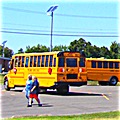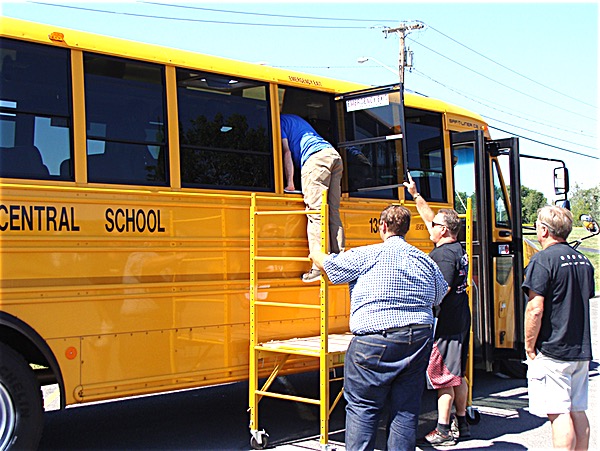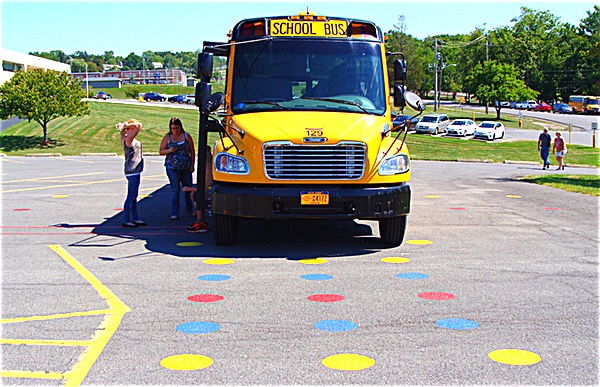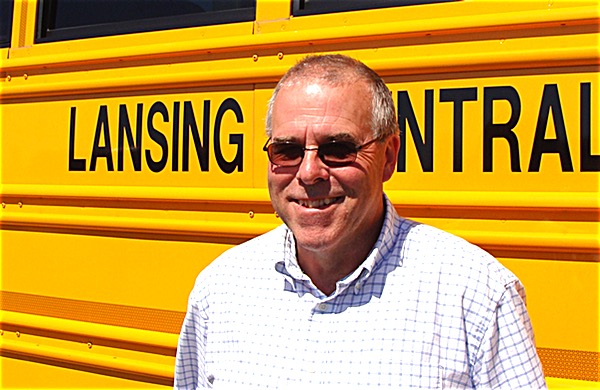- By Dan Veaner
- News
 Print
Print  This summer the local news was all about a potential water shortage. But another shortage has plagued the Lansing schools, surrounding districts, and, indeed, the nation. There is a school bus driver shortage that has already forced program cancelations and threatens to curtail more. While the Lansing district has not been unable to get kids to and from school in regular bus runs, the shortage has impacted extra-curricular activities such as sports and field trips that require transportation.
This summer the local news was all about a potential water shortage. But another shortage has plagued the Lansing schools, surrounding districts, and, indeed, the nation. There is a school bus driver shortage that has already forced program cancelations and threatens to curtail more. While the Lansing district has not been unable to get kids to and from school in regular bus runs, the shortage has impacted extra-curricular activities such as sports and field trips that require transportation."When we can't man all the buses athletic and outside trips have to be rescheduled or cancelled," says Lansing's Transportation Supervisor Roger Dedrick. "We once were able to cut an elementary route and place the students on other routes, so we were able to cover the missing bus. At the time ridership was low on that route due to parent transport and it wasn't a hardship for any of the students or parents. We limit the athletic programs to 3 buses per school day if we have enough personnel. There are numerous academic trips during the year which overlap into the pm bus time. These have caused us to change athletic departure times or caused cancellations on occasion."
The Lansing school district needs a minimum of 18 drivers and 5 monitors for a normal school day, and Dedrick prefers to have two or more standby substitutes. At present, the district has 16 regular drivers, but two more are currently in training. Lansing has several substitutes, but they are not available every day because of retirement travel or other jobs. Additionally, some students require one-on-one aids. Lansing's Transportation Department has five such aids.
 One of three teams training Tuesday (left to right): Melissa Ferris, Davis Edwards, Bill Suarez, David Barnes, Piper Cleary, Liz White, Lynda Woods, Don Brown, Judy Clarke, Jim McMillen
One of three teams training Tuesday (left to right): Melissa Ferris, Davis Edwards, Bill Suarez, David Barnes, Piper Cleary, Liz White, Lynda Woods, Don Brown, Judy Clarke, Jim McMillenDaily bus runs obviously get kids to and from school every day. The Lansing school district is also responsible for providing transportation for Lansing students who attend Peachtown Elementary School in Aurora, as well as Covenant Love Community School, Elizabeth Anne Clune Montessori, New Roots Charter School, and TST BOCES. Special education students must also be transported to Union Springs, Auburn, Binghamton and the William George Agency (formerly the George Jr. Republic).
Lansing is not alone in this challenge. The driver shortage has become a serious national crisis. A 2015 survey in School Bus Fleet magazine showed only 6% of responding districts had no shortage of school bus drivers, compared to 15% in 2014. The survey found the average starting pay for drivers was $15.15, and $54,500 for managers. 37% reported a moderate driver shortage, 21% severe, and 7% desperate.
Recent data from the US Bureau of Labor Statistics reported the average hourly wage for school bus drivers in 2014 at $14.38 as compared to $18.95 for intercity and transit drivers. Lansing bus drivers start at $18.51 for driving and $13.05 for layovers. Dedrick says regular drivers generally earn enough to meet the contract minimum to qualify for health insurance. Even so, the district continues to struggle to fill a full compliment of drivers.
Surrounding districts are in the same boat. The Trumansburg school district just filled its full-time driver quota of 19 drivers by hiring two substitute drivers for full-time runs. But they still need substitute drivers. They are paying $19.74 per hour for full-time, $18.55 for substitutes, and $10.05 for monitors with a two-hour guarantee.
 Bus drivers practice emergency procedures as part of an eight hour training session Tuesday. New York State requires two hours of training twice a year. Lansing drivers spent the day training Tuesday, and will attend another session in January.
Bus drivers practice emergency procedures as part of an eight hour training session Tuesday. New York State requires two hours of training twice a year. Lansing drivers spent the day training Tuesday, and will attend another session in January.Dedrick says the requirements are a love of kids, a civil Service application, a physical examination, a CDL (Commercial Driver's License) permit or a CDL B license with P,S endorsements (P for passengers and S for special types of buses), three references, pre-trip and driving training while waiting three months for a road test date, driver pre-service training, and a road test. That is followed by finger printing, a drug and alcohol test, and route training.
"To become a Bus driver it takes what looks like a daunting list of steps," Dedrick says. "But it is not so bad. You take it one step at a time. Van driver requirements are the same. They are limited to a van if that’s what they take the road test in. A teacher or coach can become an occasional driver of a van for up to 30 days per year. Those requirements are simpler."
Many existing Lansing drivers say the job is rewarding. They take an interest in each of their riders, and students and families are fond of them in return. They must also maintain discipline on their routes.
"Of course they have the support of the building principals and other staff," Dedrick says. "Also, cameras assist in catching those moments when the driver is focused on other tasks. Overall we have great students that are a pleasure to drive for."
Lansing School Business Administrator Mary June King says the Lansing district makes an aggressive effort to differentiate itself in the bidding war for new drivers by offering competitive wages, benefits, and by reimbursing regular drivers for expenses. But she notes all the districts are competing for what has become a coveted commodity.
"The reality is that, to a degree, we are all trying to make ours the best opportunity," she says. "At Lansing we are making sure we offer competitive wages. We also pay you to come in and train for your CDL. We believe that helps to set us apart. Also, for regular appointments (not subs), health insurance is available to drivers with at least 17 hours per week of work. These folks only pay a little over 17% of the health insurance premium. We do reimburse for fingerprinting as well. We do not reimburse subs, but often they move into a contracted status in which case we reimburse them at the time they join the bargaining unit."
 Dots have been painted on a parking lot near the bus garage so drivers can align their mirrors before driving. The dots define a 15'-around 'danger zone' that drivers need to be able to see as children get on and off their buses.
Dots have been painted on a parking lot near the bus garage so drivers can align their mirrors before driving. The dots define a 15'-around 'danger zone' that drivers need to be able to see as children get on and off their buses.The bus driver shortage not only impacts school programs, but has a trickle-down effect on non-school programs that contract for school buses, such as the Lansing Recreation Department, or events like the Lansing Fireworks. Dedrick notes that the Rec Department needs school buses four times a week, but sometimes he simply doesn't have the resources to supply them. Town Recreation Director Steve Colt says that if school buses aren't available, the higher cost of commercial bus services will either mean higher program fees or cancellation of programs.
"We know where we stand on the totem pole," Colt says. "We really have benefited, and pay for school bus trips. Those trips save our participants a lot of money, because even though we pay for them, it’s less than commercial bus prices."
Some of the Rec Department after-school programs that require transportation are the ski program, bowling, gymnastics, skating and even a bounce house program. The gymnastics program alone has grown to four sessions running from November to June.
"If we’re lucky we can get one-way trips to Jump Around Inflatables or the RINK, but on the way home parents will have to pick them up, or it may be that they just don’t happen," Colt worries. "It’s going to be tough to contract with a busing company that’s going to have to drive — as in the case of Fitzgerald — an hour and a half to get here for a ten minute trip. My hope is that some people will reach out to Roger Dedrick at the Bus Garage. It’s a great job, but it takes a special person who has the time in their day to get licensed and help us out. We need drivers."
For years King has reported major savings in the Transportation Department, due to good management practices and the use of Transfinder school bus routing software that has enabled the district to track busing needs and plan the most efficient routes.
 Lansing Central School District Transportation Supervisor Roger Dedrick
Lansing Central School District Transportation Supervisor Roger Dedrick"Even though we have found significant savings in this department over the years, personnel is not an area we look to squeeze," she says. "Having staff to assure safety of children during transport is equally important to having staff to assure their well-being and success during the school day. That is one of the things about which I am proudest of this district."
Colt also notes that current building project and field renovations have meant that additional drivers are needed every day for school functions such as busing the swim team to an alternative pool or modified teams to practice on the Town fields, pushing Town programs even lower in priority. That puts additional pressure on Dedrick and King to recruit new drivers.
"It would be nice to have 4 more drivers," Dedrick says. "We could use more subs during the winter months when some of the regular subs leave for warmer environments or travel during the school year. It's a fine line of having enough people when you need them and having so many that the part timers do not get enough work when they want it and find other things to do. The extra trips can range from zero to six a day throughout the year."
v12i35



